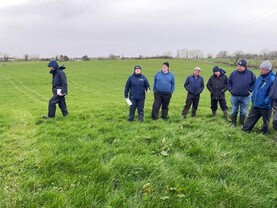With cattle rations set to cost in excess of €300/t this winter, can any livestock farmer ignore the task of getting silage tested this year?
Grabbing a handful of silage and smelling it will tell you nothing about dry matter, energy, protein and digestibility levels. But getting silage analysed for feed value will.
With good-quality silage, there will be an option to feed certain cattle groups a silage-only diet this winter, significantly cutting the meal bill.
In contrast, if silage is average or poor quality, then concentrate feeding will be required to maintain weight gain over winter.
If your plan is to skimp on meal when silage quality is poor, then don’t be surprised when animals put on very little weight during the housing period.
1 When is a silage-only diet an option?
For farmers looking to limit wintering costs by feeding a forage-only diet, it is really only an option with store cattle, or weanlings that will go back to grass next spring. Dry spring-calving cows can also be offered a silage-only diet.
Stores and weanlings need to be back at grass by late March to avail of compensatory growth to make up the potentially lower weight gain from the forage-only diet.
If cattle struggle to get back to grass before then, compensatory growth will be limited.
Finishing cattle, stores or weanlings that will be sold live next spring and autumn-calving cows will need some form of supplementary concentrate fed along with silage during the hosing period.
2 What silage quality is needed for a forage-only diet?
For store cattle going back to grass next spring, a daily gain of 0.5kg to 0.6kg/day is fine during the winter period.
To hit the outlined weight gains on a forage-only diet, store cattle need to be offered silage at 70 DMD or higher.
Above-average silage at 67 to 69 DMD, animals will struggle to sustain the outlined weight gain during a five- to six-month housing period.
Feeding 1kg/day along with 69 DMD silage and 1.5kg/day with 67 DMD silage will see animals hitting the target weight gains.
For silage at 65 to 66 DMD, increase meal levels to 2kg/day.
3 What is the potential cost saving?
For farmers looking at saving on purchased feed costs, what is the potential cost savings between a high-quality silage-only diet and that of moderate quality fodder?
Assuming cattle are housed from 15 October to 25 March, the housing period lasts 160 days. Comparing stores gaining 0.5kg/day from a 70 DMD silage-only diet and again on a 66 DMD silage with 2kg/day of concentrate costing €315/t, the meal saving amounts to €100 per head.
For a shed with 50 stores, this cost
saving multiplies up to a net saving of €5,000.
Other limiting factors to consider
Housing space
There are other factors to consider when feeding a forage-only diet of high-quality silage. Firstly, cattle need to have adequate housing space.
Cattle that are overstocked in slatted pens will not perform to their potential, regardless of silage quality and the levels of meal fed.
This is a common issue many farmers encounter during the winter. For example, stores weighing 400kg when housed in October will have plenty of feeding and lying room. By January, this may not be the case.
Assuming 10 steers weigh 400kg when housed in October, with a daily gain of 0.5kg/head, the group amasses 35kg of liveweight every week.
This means after 11 to 12 weeks, the total weight gain by the group is the equivalent of adding an extra animal to the pen. By next March, there would be the equivalent of two extra cattle in the group. Therefore, when housing cattle in October, work to the animals’ turnout weight in March/April for lying space rather than housing weight.
Keep silage fresh
Silage can be high-quality in terms of feed value, but it needs to be kept fresh so that intakes are high.
Feeding fresh silage daily is extra work, but intakes and ultimately cattle performance will be improved.
The older, uneaten silage can be removed and offered to lower-priority cattle such as dry cows.
Healthy cattle
Another factor is making sure cattle are free of internal and external parasites, as well as having adequate shed ventilation.
Make sure fluke, worming and lice control is up to date. Late fluke and worm treatments, or poor dosing technique, will hit weight gain.
Read more
Dairy management: tips for the last grazing rotation
Dairy-beef system aiming for €500/ha net margin
With cattle rations set to cost in excess of €300/t this winter, can any livestock farmer ignore the task of getting silage tested this year?
Grabbing a handful of silage and smelling it will tell you nothing about dry matter, energy, protein and digestibility levels. But getting silage analysed for feed value will.
With good-quality silage, there will be an option to feed certain cattle groups a silage-only diet this winter, significantly cutting the meal bill.
In contrast, if silage is average or poor quality, then concentrate feeding will be required to maintain weight gain over winter.
If your plan is to skimp on meal when silage quality is poor, then don’t be surprised when animals put on very little weight during the housing period.
1 When is a silage-only diet an option?
For farmers looking to limit wintering costs by feeding a forage-only diet, it is really only an option with store cattle, or weanlings that will go back to grass next spring. Dry spring-calving cows can also be offered a silage-only diet.
Stores and weanlings need to be back at grass by late March to avail of compensatory growth to make up the potentially lower weight gain from the forage-only diet.
If cattle struggle to get back to grass before then, compensatory growth will be limited.
Finishing cattle, stores or weanlings that will be sold live next spring and autumn-calving cows will need some form of supplementary concentrate fed along with silage during the hosing period.
2 What silage quality is needed for a forage-only diet?
For store cattle going back to grass next spring, a daily gain of 0.5kg to 0.6kg/day is fine during the winter period.
To hit the outlined weight gains on a forage-only diet, store cattle need to be offered silage at 70 DMD or higher.
Above-average silage at 67 to 69 DMD, animals will struggle to sustain the outlined weight gain during a five- to six-month housing period.
Feeding 1kg/day along with 69 DMD silage and 1.5kg/day with 67 DMD silage will see animals hitting the target weight gains.
For silage at 65 to 66 DMD, increase meal levels to 2kg/day.
3 What is the potential cost saving?
For farmers looking at saving on purchased feed costs, what is the potential cost savings between a high-quality silage-only diet and that of moderate quality fodder?
Assuming cattle are housed from 15 October to 25 March, the housing period lasts 160 days. Comparing stores gaining 0.5kg/day from a 70 DMD silage-only diet and again on a 66 DMD silage with 2kg/day of concentrate costing €315/t, the meal saving amounts to €100 per head.
For a shed with 50 stores, this cost
saving multiplies up to a net saving of €5,000.
Other limiting factors to consider
Housing space
There are other factors to consider when feeding a forage-only diet of high-quality silage. Firstly, cattle need to have adequate housing space.
Cattle that are overstocked in slatted pens will not perform to their potential, regardless of silage quality and the levels of meal fed.
This is a common issue many farmers encounter during the winter. For example, stores weighing 400kg when housed in October will have plenty of feeding and lying room. By January, this may not be the case.
Assuming 10 steers weigh 400kg when housed in October, with a daily gain of 0.5kg/head, the group amasses 35kg of liveweight every week.
This means after 11 to 12 weeks, the total weight gain by the group is the equivalent of adding an extra animal to the pen. By next March, there would be the equivalent of two extra cattle in the group. Therefore, when housing cattle in October, work to the animals’ turnout weight in March/April for lying space rather than housing weight.
Keep silage fresh
Silage can be high-quality in terms of feed value, but it needs to be kept fresh so that intakes are high.
Feeding fresh silage daily is extra work, but intakes and ultimately cattle performance will be improved.
The older, uneaten silage can be removed and offered to lower-priority cattle such as dry cows.
Healthy cattle
Another factor is making sure cattle are free of internal and external parasites, as well as having adequate shed ventilation.
Make sure fluke, worming and lice control is up to date. Late fluke and worm treatments, or poor dosing technique, will hit weight gain.
Read more
Dairy management: tips for the last grazing rotation
Dairy-beef system aiming for €500/ha net margin






 This is a subscriber-only article
This is a subscriber-only article










SHARING OPTIONS: